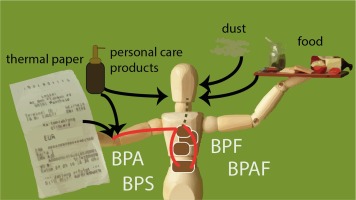当前位置:
X-MOL 学术
›
Environ. Int.
›
论文详情
Our official English website, www.x-mol.net, welcomes your
feedback! (Note: you will need to create a separate account there.)
The EuroMix human biomonitoring study: Source-to-dose modeling of cumulative and aggregate exposure for the bisphenols BPA, BPS, and BPF and comparison with measured urinary levels.
Environment International ( IF 10.3 ) Pub Date : 2019-12-26 , DOI: 10.1016/j.envint.2019.105397 Cecile Karrer 1 , Monica Andreassen 2 , Natalie von Goetz 3 , Friederike Sonnet 2 , Amrit Kaur Sakhi 4 , Konrad Hungerbühler 1 , Hubert Dirven 2 , Trine Husøy 2
Environment International ( IF 10.3 ) Pub Date : 2019-12-26 , DOI: 10.1016/j.envint.2019.105397 Cecile Karrer 1 , Monica Andreassen 2 , Natalie von Goetz 3 , Friederike Sonnet 2 , Amrit Kaur Sakhi 4 , Konrad Hungerbühler 1 , Hubert Dirven 2 , Trine Husøy 2
Affiliation

|
BACKGROUND
Bisphenol A (BPA) and, with increasing occurrence, its analogs bisphenol S (BPS) and bisphenol F (BPF) are applied in many consumer products, leading to humans being exposed from a vast number of sources and via several routes. Estrogenic and anti-androgenic effects are exerted by the chemical BPA, and also by its analogs. Therefore, realistic exposure assessments are needed for assessing risks related to cumulative exposure.
OBJECTIVES
Biomonitoring for BPA, BPS, and BPF was conducted in a human study embedded in the EU project EuroMix and the measured urinary concentrations were compared to source-to-dose calculations for source allocation and plausibility test of the model.
METHODS
For two 24-hour study periods separated by 2-3 weeks, 144 adult volunteers in Norway kept detailed diaries on food consumption, personal care product (PCP) use, and thermal paper (TP) handling. Concurrently, 24 h urine was collected and urinary levels of BPA, BPS, and BPF were analyzed using ultra-high performance liquid chromatography and tandem mass spectrometry (UPLC-MS-MS). In line with the information obtained from the first study day, bisphenol exposure from food, PCPs, TP, and dust was modeled primarily individual-based with probabilistic models. Estimates for BP excretion over 24 h were obtained with the models and compared to measured amounts.
RESULTS
Modeled aggregate internal exposures covered the full range of measured urinary amounts for all BP analogs. In general, individual-based medians of modeled BPA exposures were in good agreement with the measurements, but individual-specific correlation was lacking. Modeled exposures mostly underestimated BPS and BPF levels in participants with positive measurements (53% and 8%), except for the P95 values of modeled BPS exposure that were higher than measured amounts if TP was handled. Most likely, diet and TP were the sources contributing the most to BP exposure in this study. Urinary measurements did not reveal a significant correlation between the amounts of canned food consumed, the number of PCPs used, or the number of TP handling events and levels of BPA, BPS, or BPF.
CONCLUSIONS
The good agreement between the ranges of modeled BPA exposure and measured BPA amounts indicates that available concentrations, especially from the main exposure source food, mirror the exposure situation realistically, and suggests that the exposure model considers the relevant exposure sources. The lack of individual-specific correlations means that the individual measured amounts and modeled exposures did not vary in parallel, e.g. due to mismatch of BP concentrations in food, TP, and other sources, or delayed internal exposure. The underestimation of modeled BPS and BPF exposure suggests that not all relevant sources were included in the respective exposure models. This could be due to a lack of input data, e.g. for food items, or due to an increased replacement of BPA with structural analogs compared to the used concentration and occurrence data.
中文翻译:

EuroMix人类生物监测研究:双酚BPA,BPS和BPF的累积和聚集暴露量的剂量-剂量模型,并与测得的尿液水平进行比较。
背景技术双酚A(BPA)及其类似物双酚S(BPS)和双酚F(BPF)越来越多地应用于许多消费产品中,导致人类从众多来源和途径中暴露出来。雌激素和抗雄激素作用是由化学双酚A及其类似物发挥的。因此,需要实际的暴露评估来评估与累积暴露有关的风险。目的对BPA,BPS和BPF进行生物监测是在一项纳入欧盟项目EuroMix的人体研究中进行的,并将测得的尿液浓度与源剂量计算进行了比较,以进行模型的源分配和真实性测试。方法在两个2-3周之间的24小时学习期中,挪威的144名成年志愿者保存了有关食物消耗的详细日记,个人护理产品(PCP)的使用和热敏纸(TP)的处理。同时,收集24小时尿液,并使用超高效液相色谱和串联质谱(UPLC-MS-MS)分析尿中BPA,BPS和BPF的水平。根据从第一个研究日获得的信息,对食物,五氯苯酚,总磷和粉尘中双酚的暴露主要采用基于概率的模型进行个体建模。使用模型获得了24小时内BP排泄的估计值,并将其与测量值进行了比较。结果建模的内部总暴露量涵盖了所有BP类似物的全部测得尿量。通常,建模的BPA暴露的基于个体的中位数与测量值非常吻合,但是缺乏个体特异性的相关性。建模的暴露量大多低估了阳性参与者的BPS和BPF水平(53%和8%),但如果处理TP,建模的BPS暴露量的P95值高于测量值。在这项研究中,饮食和TP最有可能是导致BP暴露的最大因素。尿液测量没有显示罐头食品的消费量,所用PCP的数量或TP处理事件的数量与BPA,BPS或BPF含量之间的显着相关性。结论建模的BPA暴露范围与测得的BPA量范围之间的良好一致性表明,可用浓度(尤其是主要暴露源食品中的可用浓度)真实地反映了暴露情况,并建议暴露模型考虑了相关的暴露源。缺乏个体特异性的相关性意味着个体测量的量和模拟的暴露量没有平行变化,例如,由于食品,总磷和其他来源中的BP浓度不匹配或内部暴露延迟。对BPS和BPF暴露模型的低估表明,并非所有相关来源都被包括在各自的暴露模型中。这可能是由于缺乏例如食品的输入数据,或者是由于与使用的浓度和发生数据相比,BPA被结构类似物替代的增加。对BPS和BPF暴露模型的低估表明,并非所有相关来源都被包括在各自的暴露模型中。这可能是由于缺乏例如食品的输入数据,或者是由于与使用的浓度和发生数据相比,BPA被结构类似物替代的增加。对BPS和BPF暴露模型的低估表明,并非所有相关来源都被包括在各自的暴露模型中。这可能是由于缺乏例如食品的输入数据,或者是由于与使用的浓度和发生数据相比,BPA被结构类似物替代的增加。
更新日期:2019-12-27
中文翻译:

EuroMix人类生物监测研究:双酚BPA,BPS和BPF的累积和聚集暴露量的剂量-剂量模型,并与测得的尿液水平进行比较。
背景技术双酚A(BPA)及其类似物双酚S(BPS)和双酚F(BPF)越来越多地应用于许多消费产品中,导致人类从众多来源和途径中暴露出来。雌激素和抗雄激素作用是由化学双酚A及其类似物发挥的。因此,需要实际的暴露评估来评估与累积暴露有关的风险。目的对BPA,BPS和BPF进行生物监测是在一项纳入欧盟项目EuroMix的人体研究中进行的,并将测得的尿液浓度与源剂量计算进行了比较,以进行模型的源分配和真实性测试。方法在两个2-3周之间的24小时学习期中,挪威的144名成年志愿者保存了有关食物消耗的详细日记,个人护理产品(PCP)的使用和热敏纸(TP)的处理。同时,收集24小时尿液,并使用超高效液相色谱和串联质谱(UPLC-MS-MS)分析尿中BPA,BPS和BPF的水平。根据从第一个研究日获得的信息,对食物,五氯苯酚,总磷和粉尘中双酚的暴露主要采用基于概率的模型进行个体建模。使用模型获得了24小时内BP排泄的估计值,并将其与测量值进行了比较。结果建模的内部总暴露量涵盖了所有BP类似物的全部测得尿量。通常,建模的BPA暴露的基于个体的中位数与测量值非常吻合,但是缺乏个体特异性的相关性。建模的暴露量大多低估了阳性参与者的BPS和BPF水平(53%和8%),但如果处理TP,建模的BPS暴露量的P95值高于测量值。在这项研究中,饮食和TP最有可能是导致BP暴露的最大因素。尿液测量没有显示罐头食品的消费量,所用PCP的数量或TP处理事件的数量与BPA,BPS或BPF含量之间的显着相关性。结论建模的BPA暴露范围与测得的BPA量范围之间的良好一致性表明,可用浓度(尤其是主要暴露源食品中的可用浓度)真实地反映了暴露情况,并建议暴露模型考虑了相关的暴露源。缺乏个体特异性的相关性意味着个体测量的量和模拟的暴露量没有平行变化,例如,由于食品,总磷和其他来源中的BP浓度不匹配或内部暴露延迟。对BPS和BPF暴露模型的低估表明,并非所有相关来源都被包括在各自的暴露模型中。这可能是由于缺乏例如食品的输入数据,或者是由于与使用的浓度和发生数据相比,BPA被结构类似物替代的增加。对BPS和BPF暴露模型的低估表明,并非所有相关来源都被包括在各自的暴露模型中。这可能是由于缺乏例如食品的输入数据,或者是由于与使用的浓度和发生数据相比,BPA被结构类似物替代的增加。对BPS和BPF暴露模型的低估表明,并非所有相关来源都被包括在各自的暴露模型中。这可能是由于缺乏例如食品的输入数据,或者是由于与使用的浓度和发生数据相比,BPA被结构类似物替代的增加。







































 京公网安备 11010802027423号
京公网安备 11010802027423号